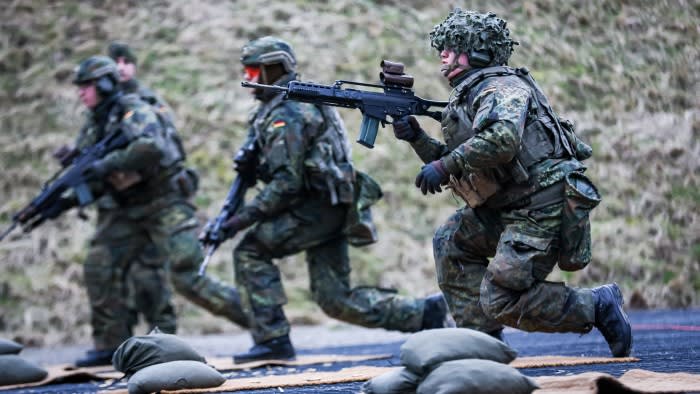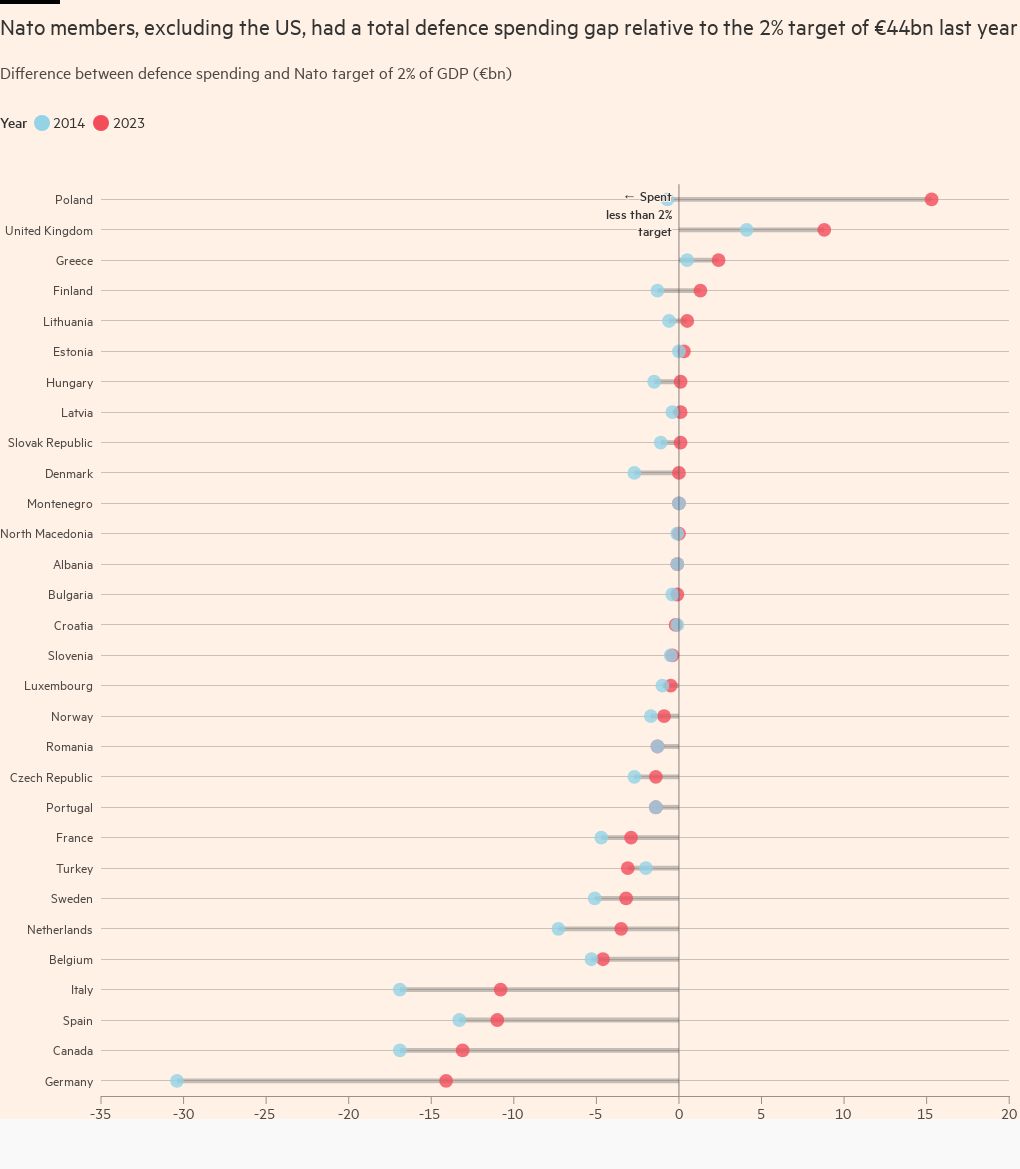Open Editor's Digest for free
Rula Khalaf, editor of the Financial Times, selects her favorite stories in this weekly newsletter.
European members of NATO need to find an additional 56 billion euros annually to meet the alliance's defense spending target, but the deficit has been halved in the past decade, according to research conducted by the German Ifo Institute for the Financial Times.
The research showed that several of the EU countries with the biggest shortfalls in NATO's target for defense spending of 2 percent of GDP – including Italy, Spain and Belgium – also have the highest levels of debt and budget deficits in Europe.
Efforts by the 32 member states of the US-led coalition to boost defense spending in response to Russia's all-out invasion of Ukraine are fueling budget pressures in Europe at a time of low growth and when many countries are tightening their fiscal plans. Economists say this will make it harder for laggards to close the gap.
The largest deficit in terms of value was in Germany, which last year spent 14 billion euros less than needed to meet the index, according to Ifo magazine. But Berlin has succeeded in reducing this gap by half in the past decade, after adjusting for inflation, and plans to close it completely this year.
The next largest European deficit was €11 billion in Spain, €10.8 billion in Italy, and €4.6 billion in Belgium. These three countries were among six countries in the European Union whose debt exceeded 100 percent of their gross domestic product last year. Italy also has one of the highest budget deficits in the European Union at 7.2 percent, and interest costs are expected to rise to more than 9 percent of government revenues this year.
“Countries with high debt levels and high interest costs have little room to raise more debt, so the only real way to do this is to cut spending in other areas,” said Marcel Schleper, an economist at Ifo. “This is not easy, as we saw when Germany tried to cut subsidies on agricultural diesel and farmers came out to protest.”
US State Department spokesman Matthew Miller acknowledged this week that there had been an “improvement” in EU efforts to bring all NATO members to the 2 percent threshold. Washington has long wanted Europe to spend more on its defense.
Last year, two-thirds of NATO's total defense spending, €1.2 trillion, was from the United States, more than double the €361 billion spent by EU members, the United Kingdom and Norway combined.
New EU fiscal rules, which will be implemented from next year, are set to lead to further budget cuts as countries seek to adhere to a 3 percent annual deficit limit and a 60 percent debt-to-GDP threshold. More than 10 countries in the bloc are expected to breach the annual deficit limit, which would likely lead to sanctions by the European Commission.
But during negotiations that ended last year, Poland, the Baltic states and Italy successfully campaigned to treat defense spending more favorably under the new rules. The Committee will therefore consider military spending as a mitigating factor when assessing whether action should be taken against countries that violate the annual deficit limit.
In cases such as Poland, which in 2024 is scheduled to spend more than 4 percent of its production on defense – the highest among NATO members – and thus violate EU fiscal limits, this is likely to lead to a more lenient assessment of its ability to Defense. budget.
NATO Secretary-General Jens Stoltenberg told reporters on Thursday that two-thirds of members would meet the 2 percent target this year, compared to just three in 2014 when the defense investment pledge was agreed after Russia's annexation of Crimea.
Eurozone countries are on track to double their defense spending from €150 billion in 2021 to €320 billion in 2026, according to Pantheon Macroeconomics, which estimated this would boost sluggish growth by 0.2 to 0.3 percent. Norway this week became the latest European NATO member to say it will meet the alliance's 2 percent target in 2024, a year ahead of schedule.
Lorenzo Codogno, a former Italian treasury official who now works as an economic adviser, said it would be “difficult” for Italy, whose debt exceeded 140 percent of GDP last year, to reach the NATO target “if there is no special exemption under European Union. Rules or no money from the EU.”
“The Russian threat is not seen as serious enough to justify, for example, cutting welfare spending to make room for weapons,” he said.
Opinion polls conducted by NATO have shown declining public support for increased defense spending in some of the countries with the largest shortfalls. Only 28% of Italians believe that their country should increase military spending, while 62% want it to spend the same percentage or less.
Despite being home to the headquarters of the North Atlantic Treaty Organization (NATO), Belgium's defense spending amounted to just 1.21 percent of GDP last year, one of the lowest rates in the alliance, according to new figures released on Thursday. Spain was not much higher at 1.24 percent and Italy at 1.47 percent.
Excluding the seven European countries that said they were aiming to meet NATO's 2 percent target this year, including new member Sweden, the Ifo institute found that the European deficit would remain at 35 billion euros.
“We are moving in the right direction, but too slowly and too late,” Polish Foreign Minister Radoslaw Sikorski said on Friday, noting that Russian defense spending is expected to reach 7 percent of GDP this year. “The Russian economy is already operating on a war footing. European economies need to switch to at least crisis mode.


